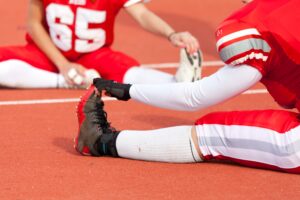If you’re an athlete, it’s time to stop static stretching.
Static stretching is bad for you if you are about to play any sport. Surprised? Don’t be. Plenty of data is provided below. In spite of what has been incorrected pushed for decades at every level of sport, the research has shown for decades that static stretching leads to decreased performance and a greater likelihood of injury. So many injuries could be prevented if ‘warming up’ was performed properly, by everyone. Watch the video below and read the blog to learn more. Please also subscribe to our YouTube channel. Help us help you and those you care about!

Here’s a classic one. This may be one reason so many football players end up with hamstring and groin injuries when coming back from the summer.
So, when we see kids up to pro athletes static stretching before a game, tell them to ‘STOP NOW!’ Static stretching impairs sprint performance in collegiate track and field athletes and it also has negative effects on jumping ability. If you insist on performing any static stretching before any sports participation, at least keep it under 30 seconds. Even then, it’s strongly suggested you don’t perform it!
If you don’t want to be able to sprint during your sport, then by all means perform some static stretching (sarcasm implied). Soccer and other running sports require a certain amount of lower extremity power. We certainly do not want to decrease this before we participate in sport. However, static stretching will decrease lower extremity power. Yikes. It also will decrease your ability to jump (yes, another study on this). It doesn’t matter if you stretch before or after a dynamic warmup. If you static stretch, you’re reducing your ability to jump (and even a third study). Want to get in the air and head the ball into the net? Don’t static stretch!

The static quad stretch is good for one thing: getting a quad strain during the game. Avoid these stretches at all costs.
We should be getting the point now but there are more studies to reference if we still insist on lowering performance and increasing injury. At this point, I’d like to point out that static stretching decreases power when we are straightening out our leg. Oh boy. Let’s look at one sport with this topic: soccer.
In soccer, we mostly straighten our leg when we use it as a plant leg and the kicking leg also straightens out when you kick. Since static stretching has been shown to reduce power when the leg is straightened, then we certainly want to avoid this problem. We lose power with the plant leg along with losing power in the kicking leg. This is not a good thing. Also consider that if we are losing power when we straighten the knee, we are also likely increasing our likelihood of injury. How about sprinting and reduction in power. I don’t know many athletes who want to run slower.
If we partake in dynamic or other form of active warmups, this is much preferred (ah, I feel another blog and video on this soon). Even when a static stretch is added following active stretching, it leads to reduced function.
So many studies above. So much information that athletes, coaches, and fitness professionals need to follow. Let’s just keep it as simple as possible. DO NOT STATIC STRETCH before any activity. Spread the word. Don’t Be A Meathead!

We’re going running and we’re stretching…why? So I stretch my shoulder in adduction even though it’ll only be moving in the sagittal plane when I’m running? Oh boy! Oh, and here’s that quad strain stretch again…
With all the information provided above, what is the reasoning for getting rid of the dreaded static stretch before participation in sport? I’ll keep it simple. When you stretch, you are asking the muscle spindles to release so that you can increase the stretch. The spindles don’t really like to stretch and they fight you. You fight back and force a greater stretch.
The muscle thinks it’s going to tear and it only has two options: 1. It tears. 2. It shuts off to avoid the tear. In order for this to occur, the appropriately called stretch receptors, otherwise known as Golgi Tendon organs, signal the muscle spindle to release. This is great to avoid tearing the muscle, but the effects of the shut-off last for quite a long period of time. When you perform a stretch and then go into your sport, you are asking muscle to work that have essentially been shut off. When you ask them to work again, they can’t. They either don’t perform or they will tear.
Athletes need their muscles to work. They rely on a combination of mobility (to allow them to function on the field), and stability (to help reduce the likelihood of injury). Static stretching reduces the stability of the body at the cost of unnecessary mobility. It weakens you and increases injury risk.
As previously stated, if you want to stretch, do so after your game and give your body time to recover. This is acceptable and far safer.
Before your game, warm-up appropriately. This means gets your body moving. A combination of dynamic warmups/active warmups are what your body needs to get ready for sport. Your warm-up should not only be sport-specific but should also include activities to increase heart rate and improve circulation in the muscles that are going to be loaded by the sport.
Don’t Be a Meathead is protected by Copyright laws. If you wish to post any content from www.dontbeameathead.com, you must obtain express (written…this can be email) permission before doing so. We love sharing important information to help people and we do appreciate your respect for our intellectual property.





